A Look At Triple-GPU Performance And Multi-GPU Scaling, Part 1
by Ryan Smith on April 3, 2011 7:00 AM ESTCiv V, Battlefield, STALKER, and DIRT 2
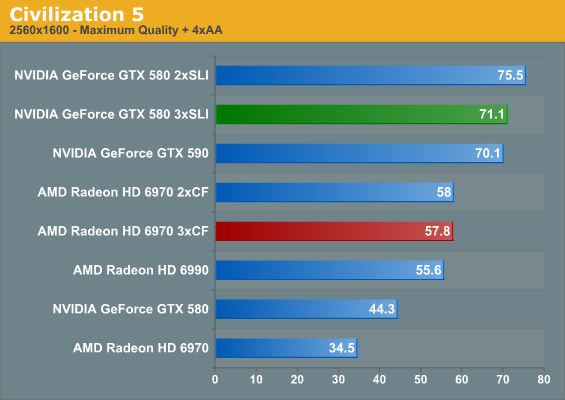
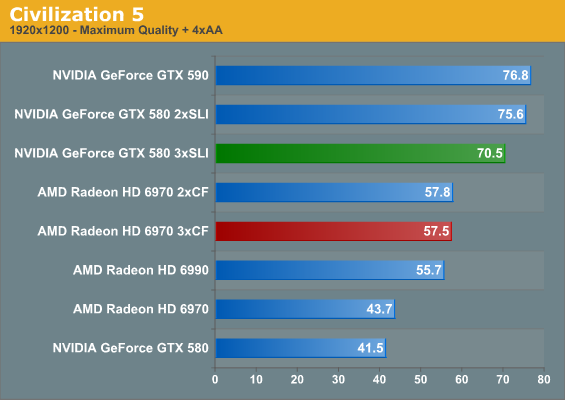
Civilization V continues to be the oddball among our benchmarks. Having started out as a title with low framerates and poor multi-GPU scaling, in recent months AMD and NVIDIA have rectified this some. As a result it’s now possible to crack 60fps at 2560 with a pair of high-end GPUs, albeit with some difficulty. In our experience Civ V is a hybrid bottlenecked game – we have every reason to believe it’s bottlenecked by the CPU at certain points, but the disparity between NVIDIA and AMD’s performance indicates there’s a big difference in how the two are settings things up under the hood.
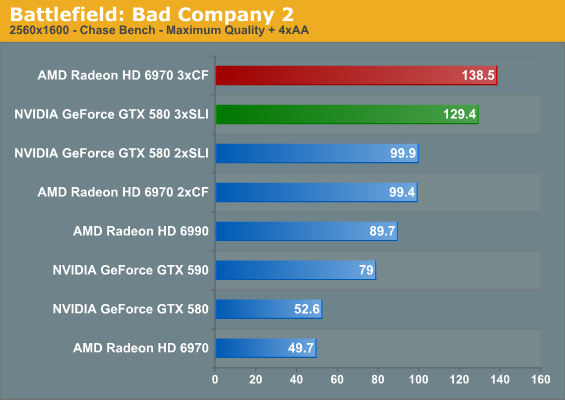
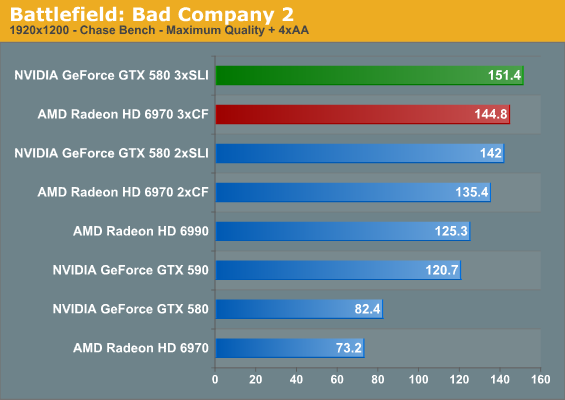
When we started using Bad Company 2 a year ago, it was actually a rather demanding benchmark; anything above 60fps at 2560 required SLI/CF. Today that’s still true, but at 52fps the GTX 580 comes close to closing that gap. On the flip side two GPUs can send scores quite a distance up, and three GPUs will push that over 120fps. Now if we could just get a 120Hz 2560 monitor…
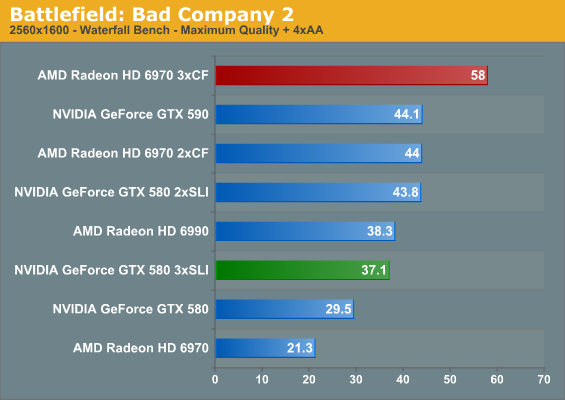
The Bad Company 2 Waterfall benchmark is our other minimum framerate benchmark, as it provides very consistent results. NVIDIA normally does well here with one GPU, but with two GPUs the gap closes to the point where NVIDIA may be CPU limited as indicated by our 580SLI/590 scores. At three GPUs AMD falls just short of a 60fps minimum, while the triple GTX 580 setup drops in performance. This would indicate uneven performance scaling for NVIDIA with three GPUs.
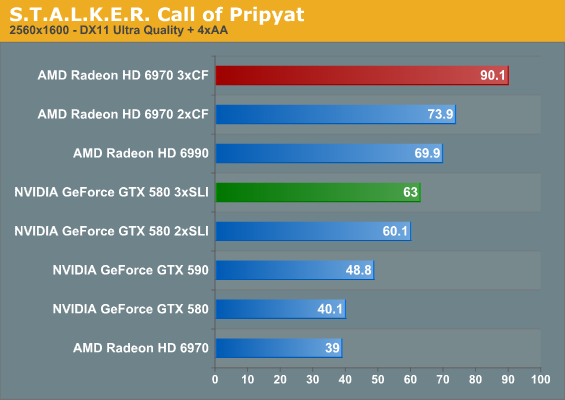
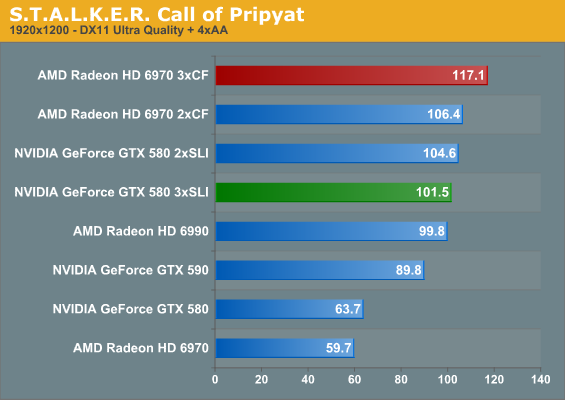
STALKER is another title that is both shader heavy and potentially VRAM-intensive. When moving from 1GB cards to 2GB cards we’ve seen the average framerate climb a respectable amount, which may be why AMD does so well here with multiple GPUs given the 512MB advantage in VRAM. With three GPUs the GTX 580 can crack 60fps, but the 6970 can clear 90fps.
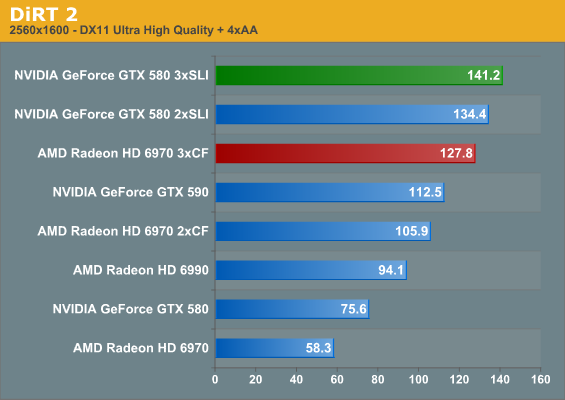
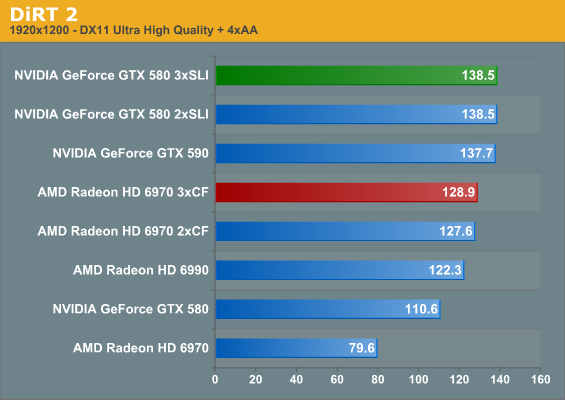
We’ve seen DiRT 2 become CPU limited with two GPUs at 1920, so it shouldn’t come as a surprise that with three GPUs a similar thing happens at 2560. Although we can never be 100% sure that we’re CPU limited versus just seeing poor scaling, the fact that our framerates top out at only a few FPS above our top 1920 scores is a solid sign of this.
| Radeon HD 6970 | GeForce GTX 580 | |||||
| GPUs | 1->2 | 2->3 | 1->3 | 1->2 | 2->3 | 1->3 |
| Civilization V | 168% | 99% | 167% | 170% | 95% | 160% |
| Battlefield: BC2 Chase | 200% | 139% | 278% | 189% | 129% | 246% |
| Battlefield: BC2 Water | 206% | 131% | 272% | 148% | 85% | 125% |
| STALKER: CoP | 189% | 121% | 231% | 149% | 104% | 157% |
| DiRT 2 | 181% | 120% | 219% | 177% | 105% | 186% |
So what does multi-GPU scaling look like in this batch of games? The numbers favor AMD at this point, particularly thanks to STALKER. Throwing out a CPU limited DIRT 2, and the average FPS for an AMD card moving from one GPU to two GPUs is 185%; NVIDIA’s gains under the same circumstances are only 169%.
For the case of two GPUs, AMD’s worst showing is Civilization V at 168%, while for NVIDIA it’s STALKER at %149. In the case of Civilization V the close gains to NVIDIA (168% vs. 170%) hides the fact that the GTX 580 already starts out at a much better framerate, so while the gains are similar the final performance is not. STALKER meanwhile presents us with an interesting case where the GTX 580 and Radeon HD 6970 start out close and end up far apart; AMD has the scaling and performance advantage thanks to NVIDIA’s limited performance gains here.
As for scaling with three GPUs, as was the case with two GPUs the results are in AMD’s favor. We still see some weak scaling at times – or none as in the case of Civilization V – but AMD’s average gain of 120% over a dual-GPU configuration isn’t too bad. NVIDIA’s average gains are basically only half AMD’s though at 110%, owing to an even larger performance loss in Civilization V, and almost no gain in STALKER. Battlefield: Bad Company 2 is the only title that NVIDIA sees significant gains in, and while the specter of CPU limits always looms overhead, I’m not sure what’s going on in STALKER for NVIDIA; perhaps we’re looking at the limits of 1.5GB of VRAM?
Looking at minimum framerates though the Battlefield: Bad Company 2, the situation is strongly in AMD’s favor for both two and three GPUs, as AMD scales practically perfectly with two GPUs and relatively well with three GPUs. I strongly believe this has more to do with the game than the technology, but at the end of the day NVIDIA’s poor triple-GPU scaling under this benchmark really puts a damper on things.










97 Comments
View All Comments
Ryan Smith - Sunday, April 3, 2011 - link
I am not highly sensitive to microstuttering (aliasing on the other hand...). In my experience nothing here microstuttered, and the only thing that performed poorly was the NV 3xGTX580 setup under Bad Company 2.james.jwb - Sunday, April 3, 2011 - link
Ryan, do you think you could re-run just a single game (you choose) but with the CPU overclocked to 4.0Ghz or higher if you can (4.5ghz if possible). 3 GPU's will surely react well to this, I'd love to see the results (for 2x, too).james.jwb - Sunday, April 3, 2011 - link
just at 2560 btw :)DanNeely - Sunday, April 3, 2011 - link
Ryan posted elsewhere that the 920 he's using is from the slow end of the bell curve and isn't stable above 3.33; so until he gets a new system this is as good as it gets.PhantomKnight - Sunday, April 3, 2011 - link
This is not the only way. There are flexible PCIe cables around on eBay. I don't know how well they would work, but it would be possible to use something like this to increase the room around the cards. http://cgi.ebay.com.au/PCI-E-PCI-Express-16X-Riser... ETC7Enigma - Tuesday, April 5, 2011 - link
Interesting. I wonder if this would harm latency somehow (or reduce the amount of power the PCIe slot can supply due to essentially using an extension cord for the gpu).masterkritiker - Sunday, April 3, 2011 - link
While it is a great article, sadly it's a limited one. The dual/triple GPU test should have been done across multiple platforms, x58/890FX/P67 regardless of some platform limited pcie lanes like the P67. Let's be honest SNB systems are the ones selling like mad right now, you'll hardly convince more people w/ an x58 system to spend money upgrading their GPU to dual/triple GPUs while SNB-E is just around the corner & their x58 systems are still great for them. Trust me people will "wait"! The test could have efficiently validated anyone deciding to upgrade from single to dual/triple GPUs across multiple platforms in either a single 1080p/1600p monitor or even multiple monitors, I guess we have to wait for the test(If that will happen).b1u3 - Monday, April 4, 2011 - link
2x590GTX vs 2x6990...ypsylon - Monday, April 4, 2011 - link
Frankly I can't get my head around this test. If you have ~2000$ to blow on 3 VGAs then there is good chance you will buy 2x590* or 2x6990. It is more logical and convenient choice.Performance by a tiny fraction lower vs 3xSLI/CF (at worst - only with reference - under-clocked - models currently available), but you'll need only 2 cards, not 3. Easier to implement, less clutter inside, and if by any chance you own a motherboard with 3* slot space between 1st and 2nd x16 slot then it is absolute win-win.
piroroadkill - Monday, April 4, 2011 - link
Quite. I don't know why 6990 CF, just like 5970 CF, was almost completely ignored by AnandTech..